Introduction
This article provides an in-depth examination of the architecture for Leena AI’s enterprise Agentic AI. It demonstrates how different layers and components interconnect to deliver AI Colleagues with human-like agency.
Above is a comprehensive description of the Leena AI “Agentic AI Architecture” diagram, breaking down each component and illustrating how they interact to form a cohesive enterprise AI solution.
The Architecture Highlights:
- Collaborate: Channels where users interact with the Agentic AI systems
- Orchestrator: Central planning and coordination engine
- AI Colleagues: Specialized AI agents based on roles or systems
- Studios – AOPs, Skills and Knowledge: To ground the Agentic system in Business Processes
- Permissions & Access Controls: Security layer ensuring compliance and role-based access
- Observability and Governance: Oversight, governance, and continuous improvement
- Security & Compliance: Adherence to industry standards like HIPAA, GDPR, SOC2, etc.
1. Collaborate – Touchpoints

Positioned at the top of the diagram are multiple touchpoints through which users and systems can interact with the AI Agents:
- Web Chat
- Voice
- SMS
- Messaging Apps (e.g., Microsoft Teams, Slack, Zoom, WhatsApp)
- API, MCP, A2A (for invoking agents on different types of triggers), and interoperability
- Intranet (internal company portals)
These touchpoints represent the diverse channels used by employees or partners to engage with the Colleagues. The architecture is channel-agnostic, meaning any new channel can be integrated with minimal overhead.
2. Orchestrator
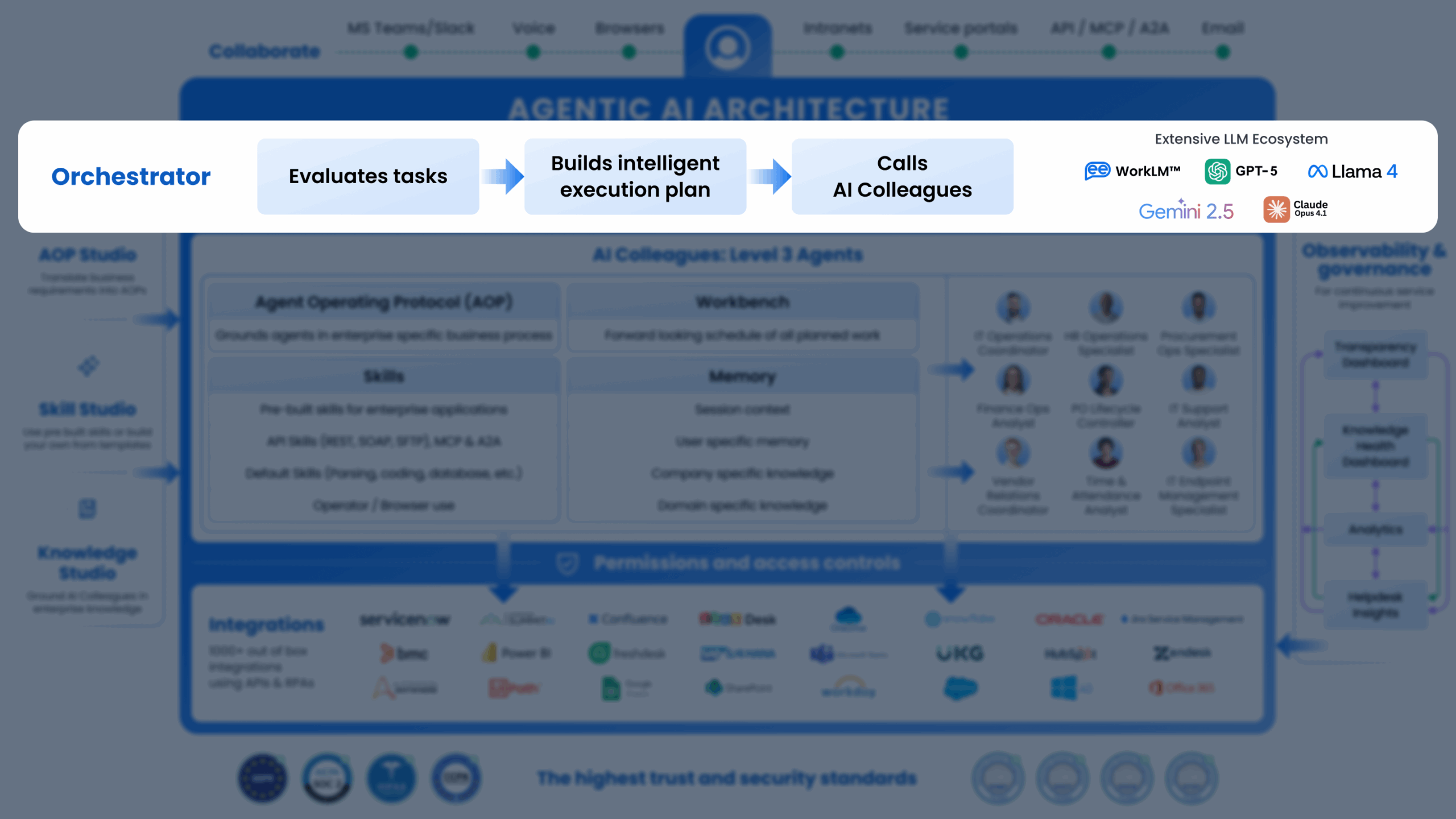 At the core of the architecture is the Orchestrator, a centralized engine responsible for:
At the core of the architecture is the Orchestrator, a centralized engine responsible for:
- Receiving Requests: From any of the touchpoints, the Orchestrator captures incoming queries, tasks, or requests.
- Intelligent Planning: The Orchestrator determines the sequence of actions or “plan” needed to fulfill each request. This can include identifying which Agents or services are needed.
- Calling AI Colleagues: Once the plan is set, the Orchestrator dispatches tasks to the appropriate Agent(s). It also monitors progress, handles dependencies & errors, and aggregates results.
3. AI Colleagues
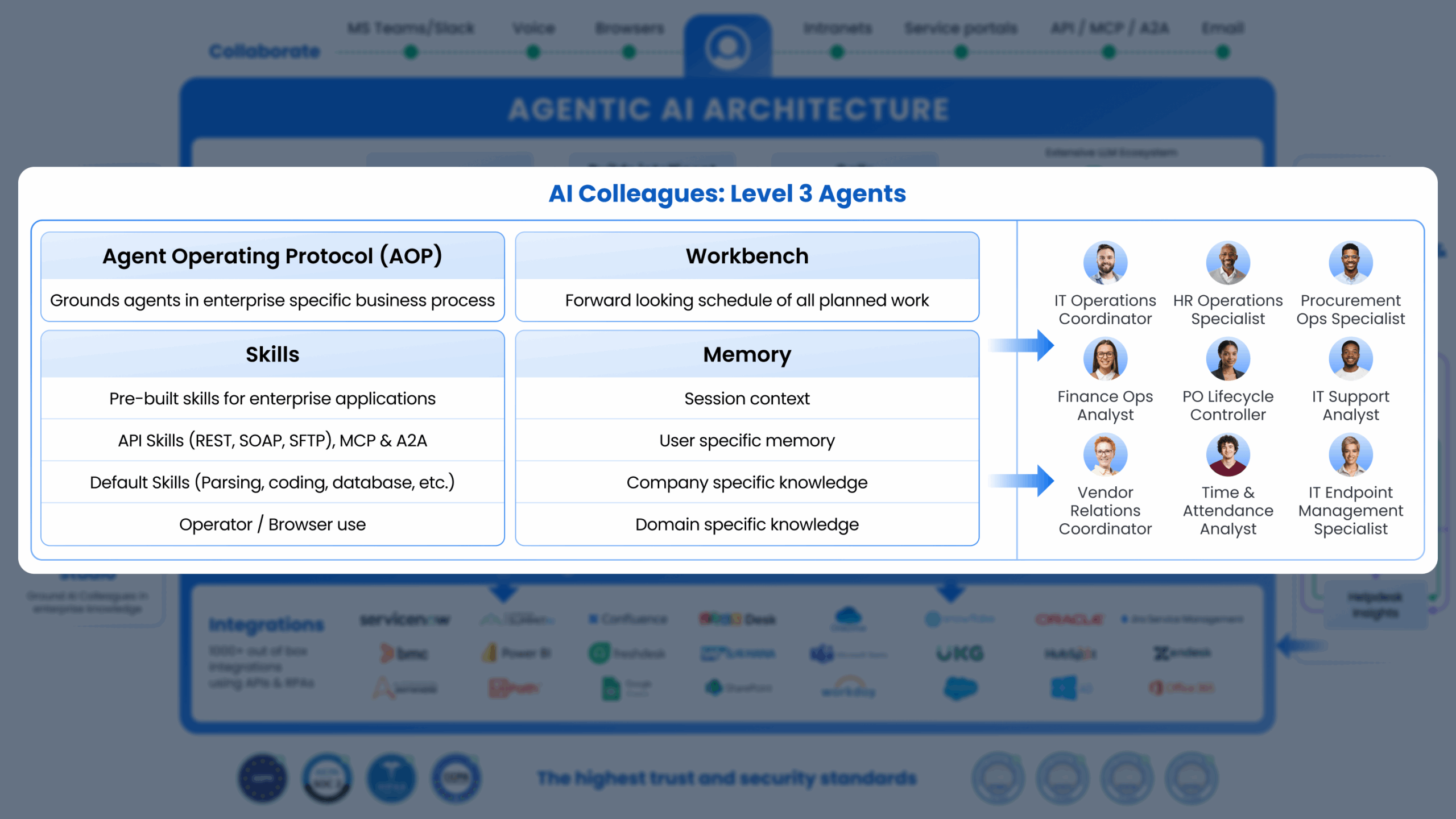 Positioned below the Orchestrator are AI Colleagues: specialized, autonomous agents designed to handle specific business functions with human-like agency. Each AI Colleague operates as a persistent digital worker within your organization, equipped with domain expertise and the ability to execute complex business processes.
Positioned below the Orchestrator are AI Colleagues: specialized, autonomous agents designed to handle specific business functions with human-like agency. Each AI Colleague operates as a persistent digital worker within your organization, equipped with domain expertise and the ability to execute complex business processes.
What Makes an AI Colleague?
Each AI Colleague is defined by:- Identity & Role: A clear job description and scope of responsibilities (e.g., IT Helpdesk Agent, Accounts Payable Analyst, HR Operations Specialist)
- Agent Operating Procedures (AOPs): Business process blueprints that guide how the agent executes tasks—similar to how SOPs guide human employees
- Specialized Skills & Knowledge: Access to relevant tools, workflows, and enterprise knowledge needed to complete their responsibilities
- Escalation Protocols: Defined pathways for handling exceptions and seeking human intervention when needed
Agent Operating Procedures (AOPs): The Bridge Between Process and Execution
AOPs are to agents what SOPs are to humans. They ground AI Colleagues in your company’s actual business processes without requiring complex, resource-intensive workflow programming. Unlike traditional automation that requires hardcoded workflows, AOPs allow you to:- Describe processes naturally: Use your existing SOPs, business process flow diagrams, or even plain text descriptions
- Adapt dynamically: AI Colleagues interpret and follow these procedures at runtime, handling variations and exceptions intelligently
- Iterate quickly: Business users can create and modify AOPs without technical expertise, dramatically reducing time-to-automation
Multi-Modal Intelligence
Each AI Colleague functions as its own orchestrator, leveraging different foundational models based on its role requirements:- Leena AI’s proprietary WorkLM (powered by Mixtral 8x22B, fine-tuned on 2TB+ of enterprise data) for enterprise-specific tasks
- Gemini models for multimodal capabilities
- Claude models for complex reasoning and analysis
- OpenAI models for low-latency requirements
Comprehensive Skill Sets
AI Colleagues are equipped with multiple types of capabilities:Enterprise-Specific Workflows
Configured in the Workflow Studio, these skills align with your company’s deterministic business processes. The platform includes 5,000+ pre-built templates across 1,000+ enterprise application integrations (Workday, SAP, ServiceNow, Salesforce, Oracle, UKG, etc.), which can be customized to your specific needs.Out-of-the-Box Skills
Every AI Colleague comes with foundational capabilities like:- Browser Use (navigating interfaces)
- Coding and data analysis
- Document processing and comparison
- Intelligent decision-making
- Code creator
Knowledge Access
Through the Knowledge Agent, AI Colleagues access your organization’s structured and unstructured knowledge—process guides, how-tos, examples, and documentation stored across systems like SharePoint, ServiceNow KM, Box, Drive, Confluence, and more.Enterprise-Wide Integration
AI Colleagues seamlessly integrate with your existing technology stack, connecting to third-party systems (ServiceNow, Workday, Salesforce, SAP SuccessFactors, Zendesk, Coupa, Snowflake, Confluence, etc.) to facilitate end-to-end process automation. They retrieve data, update systems, and orchestrate multi-step processes across your enterprise.Flexible Invocation
AI Colleagues can be triggered in multiple ways:- By users: Through conversational interfaces across any channel
- By the Master Orchestrator: When routing specific requests or tasks
- Via API: Allowing system-to-system automation
- Through schedulers: For recurring, time-based processes
- By system events: Reacting to triggers from integrated applications
Collaborative Intelligence
When an AI Colleague needs assistance beyond its defined scope, it communicates back to the Master Orchestrator to request help from another specialist agent. This ensures complex, cross-functional processes are handled seamlessly without requiring pre-programmed integration paths.4. Studios for AOPs, Skills, and Knowledge
 The AOP (Agent Operating Procedure) Studio revolutionizes how organizations create and manage automated business processes. Unlike traditional workflow builders that require technical expertise and rigid programming, the AOP Studio enables business users to define processes in natural language.
The AOP (Agent Operating Procedure) Studio revolutionizes how organizations create and manage automated business processes. Unlike traditional workflow builders that require technical expertise and rigid programming, the AOP Studio enables business users to define processes in natural language.
How It Works
Business users can create AOPs by:- Uploading existing SOPs in various formats (PDF, DOCX, flow diagrams)
- Describing processes conversationally in plain text
- Referencing company-specific procedures and business rules
From Minutes to Live
What traditionally took days or weeks of technical workflow configuration now happens in minutes:- No coding required: Business users author and modify AOPs directly
- Rapid iteration: Edit and republish AOPs as business processes evolve
- Version control: Full audit trails and the ability to roll back changes
- Testing capabilities: Validate AOPs before going live with simulation modes
Intelligent Skill Binding
The AOP Studio automatically connects process steps to the right capabilities:- Pre-built Skills from the Workflow Studio (500+ templates)
- Custom API integrations
- Default Skills like computer use, coding, and data processing
- Agent-to-Agent/MCP collaboration for cross-functional processes
Workflow Studio: Enterprise-Specific Skills
Skills are the atomic units of work that AI Colleagues execute. The Workflow Studio is where enterprise-specific deterministic workflows are configured and managed.Comprehensive Template Library
The Workflow Builder comes pre-loaded with:- 5,000+ pre-built workflow templates across common business functions
- 1,000+ enterprise application integrations: Workday, SAP, ServiceNow, Salesforce, Oracle, UKG, Coupa, BambooHR, and more
- Customizable templates that customers can adapt to their specific business processes
Knowledge Management: Enterprise Memory
The Knowledge Agent provides AI Colleagues with access to your organization’s collective intelligence—the structured and unstructured knowledge that makes them truly context-aware.Universal Knowledge Integration
Leena AI Knowledge Management (KM) integrates seamlessly with:- Enterprise knowledge management apps: SharePoint, ServiceNow KM, Box, Google Drive, Dropbox, Confluence
- Data lakes: Snowflake, Databricks, Azure S3
- Web scraping: Any website you want to incorporate into your company’s knowledge base
Optimized for Speed and Security
Rather than querying external systems at runtime (which can be slow), Leena AI KM:- Syncs and indexes all enterprise knowledge centrally
- Pre-processes content to make information instantly available to agents. Read more about pre-processing here
- Maintains security groups from all knowledge sources, ensuring permission-appropriate access
5. Permissions & Access Controls
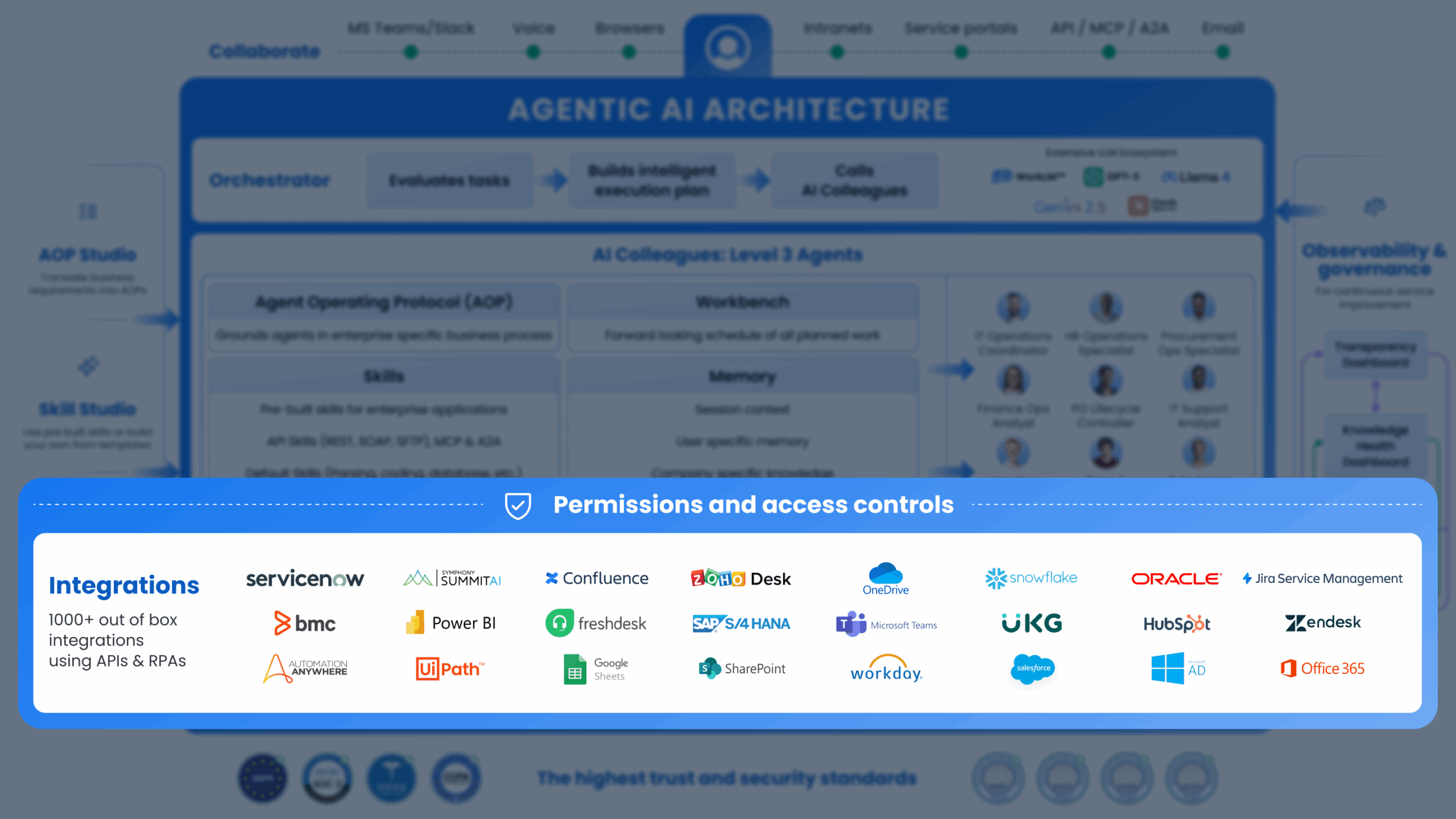
In the center, bridging the Domain-Specific Modules, there is a robust Permissions & Access Controls layer. This ensures:
- Role-Based Access: Only authorized individuals or systems can view or modify specific data.
- Security & Compliance: The system respects regulations like ISO 27001, HIPAA, GDPR, and SOC2, maintaining data privacy and integrity.
- Multi-Tenant Architecture: If the platform is deployed for multiple departments or organizations, each tenant’s data and workflows are securely isolated.
6. Observability and Governance – Responsible AI
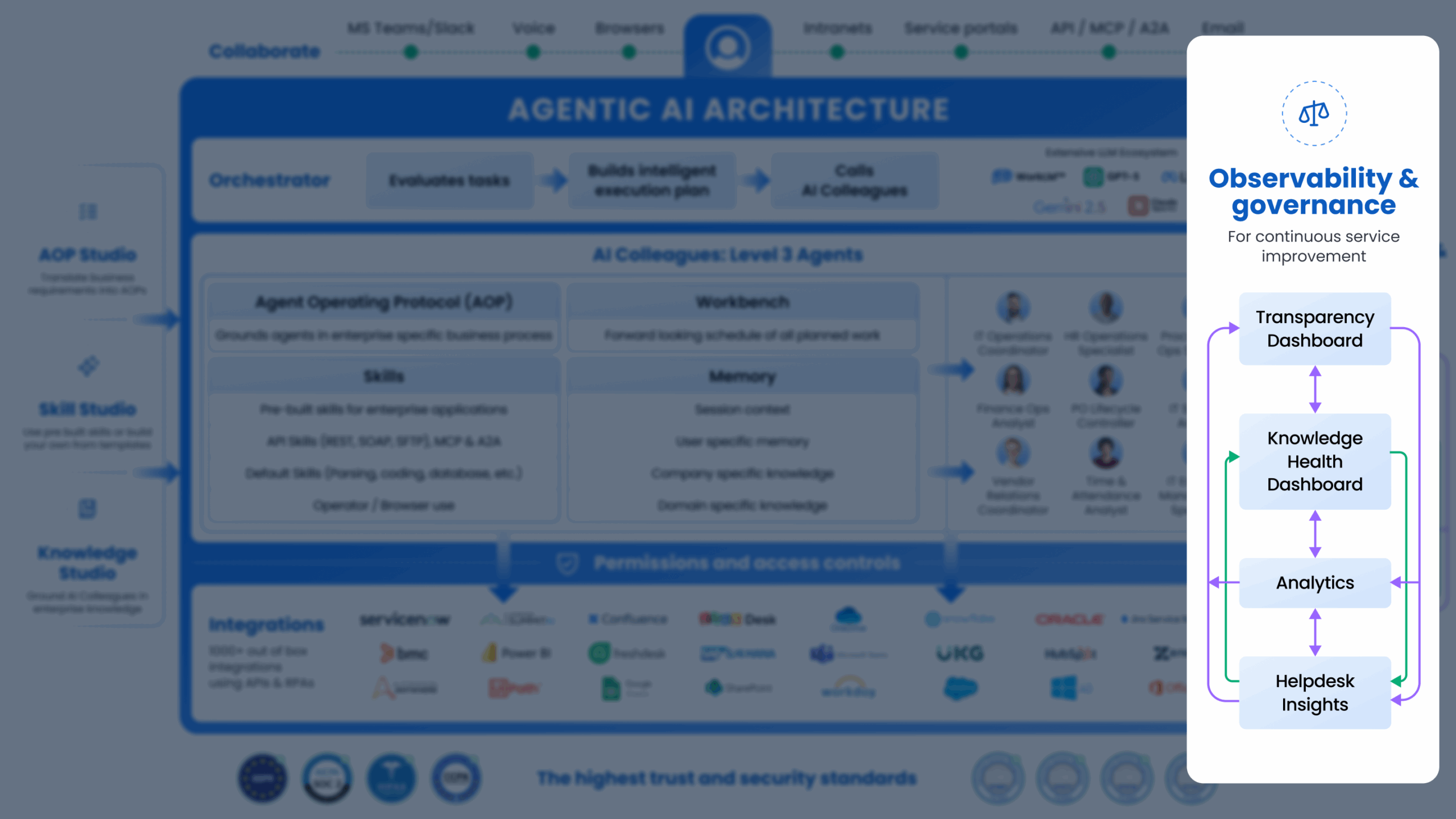 Leena AI’s Responsible AI framework governs continuous service improvement and ensures ethical, compliant use of AI. It includes:
Leena AI’s Responsible AI framework governs continuous service improvement and ensures ethical, compliant use of AI. It includes:
- Transparency Dashboard: Shows how decisions are made, providing traceability and explainability for AI-driven actions
- Knowledge Health Dashboard: When you integrate your Enterprise Knowledge into Leena AI KM, the Knowledge Health Dashboard will highlight issues in your Knowledge, like overlapping knowledge, stale knowledge, absent security groups, etc. This is extremely important to avoid Garbage-in/Garbage-out.
- Analytics: Monitors system performance, user interactions, and AI Colleagues’ accuracy. It may also track key performance indicators (KPIs) and usage metrics.
- Helpdesk Insights: Analyzes user queries, identifies trends, and recommends improvements to workflows or the Knowledge Base.
7. Security & Compliance
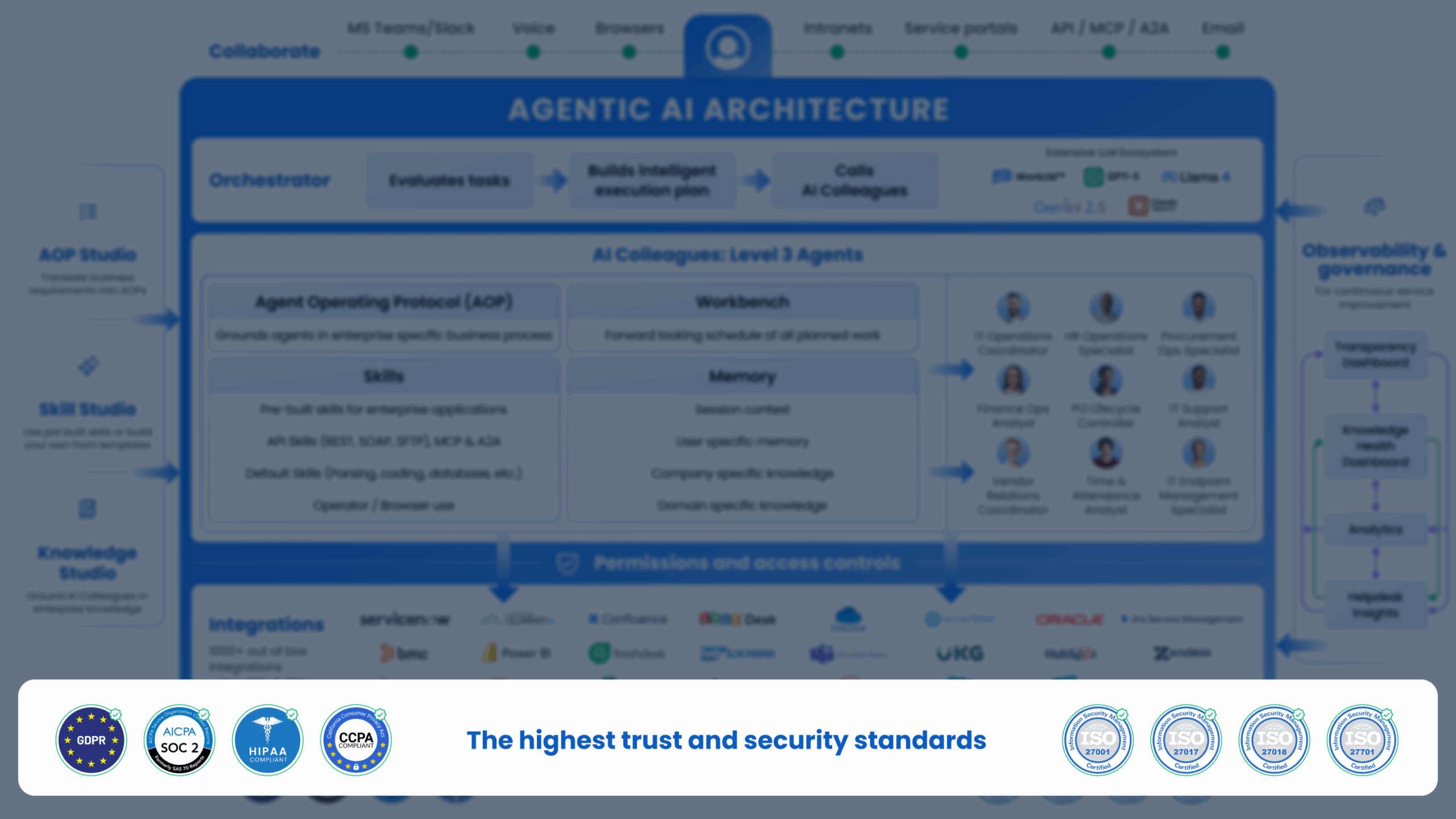 Leena AI is used by over 500+ enterprises globally and has various industry certifications and compliance with many regulations:
Leena AI is used by over 500+ enterprises globally and has various industry certifications and compliance with many regulations:
- HIPAA: Ensuring healthcare data privacy
- GDPR: European data protection requirements
- SOC2: Service Organization Control for data security and privacy
- ISO 27001: International standard for information security management.
Conclusion
Leena AI’s Agentic AI Architecture is designed to provide an end-to-end solution for enterprise-grade AI services. By combining a central Orchestrator, specialized Colleagues, Studios for Skills and AOPs, Knowledge Base, and out-of-the-box integrations, organizations can automate complex processes across different domains while maintaining strict security, compliance, and ethical standards. The incorporation of a Responsible AI framework ensures transparency, accountability, and continuous improvement – key factors for successful AI adoption in modern enterprises.
Learn More here!





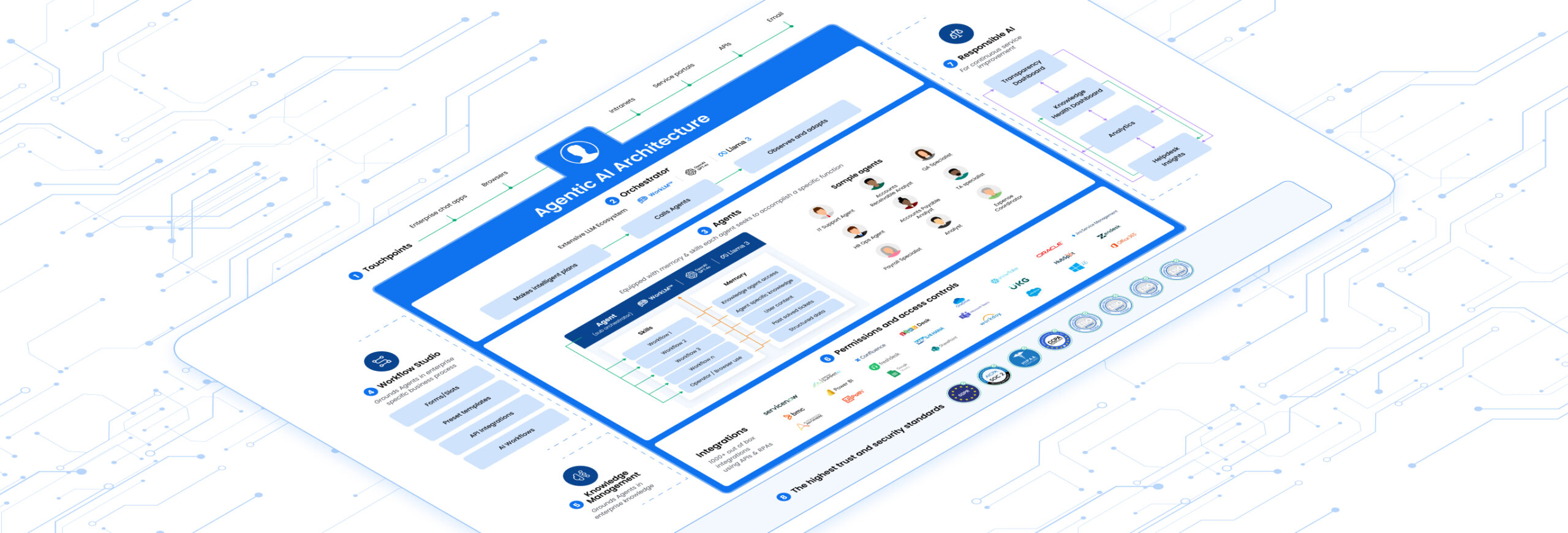








2 Comments